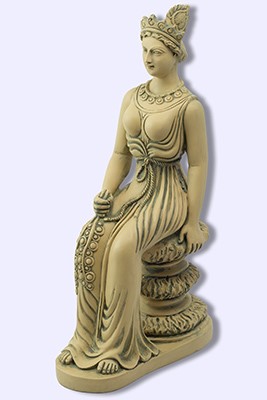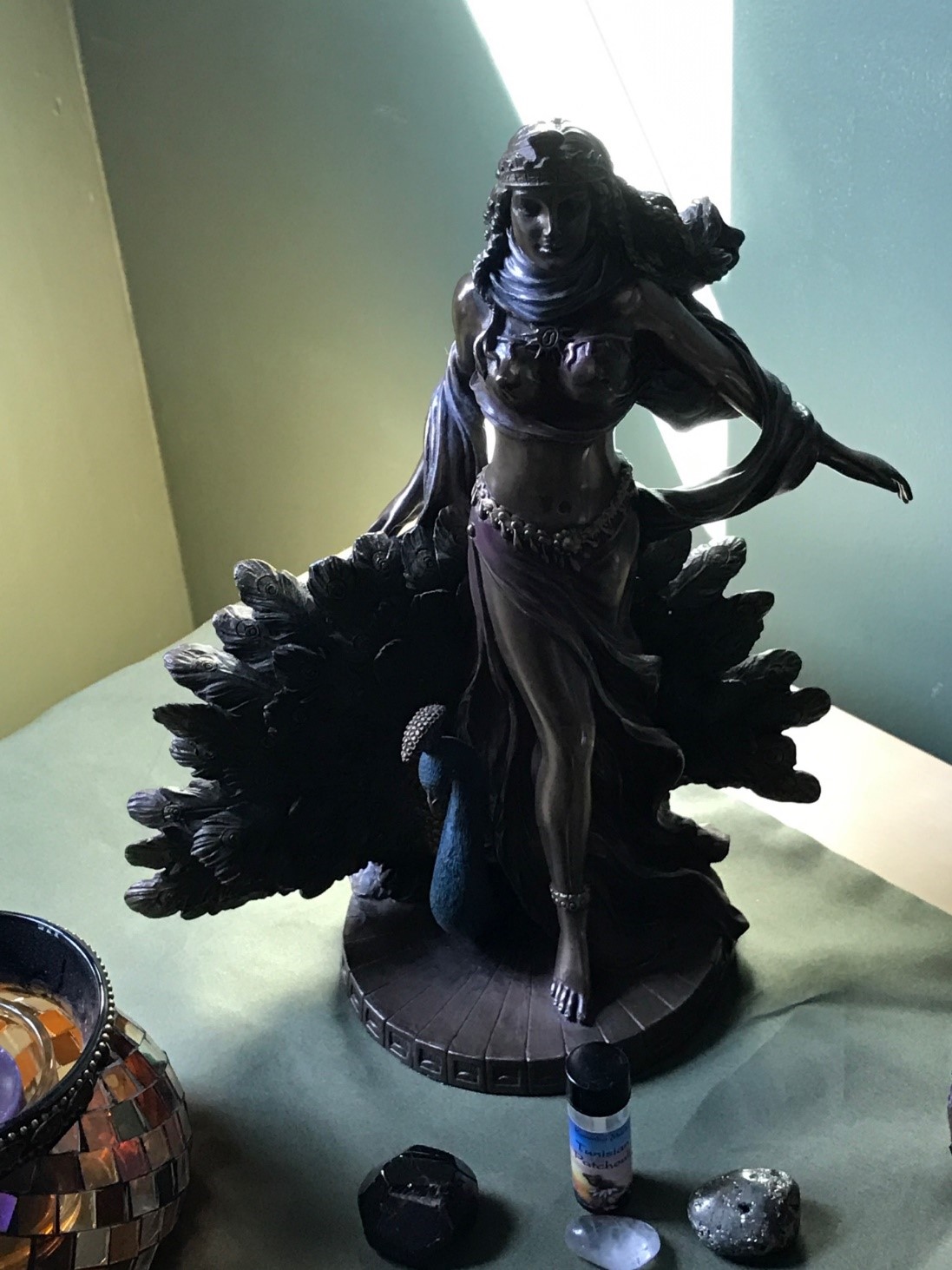Sisters of the Burning
Branch Goddess Gallery Presents...
HERA, Queen
of Olympus

https://www.sacredsource.com/Hera-statue-85/productinfo/HE/
For this
project I have chosen to honor the Greek Goddess Hera, as I see her a representative
of women who are in complex relationships with their partners, and who guard
their homes and children from the threat of others.
Lineage: Hera is the great mother goddess who was worshipped in the matriarchal society of pre-Hellenic Greece (Cotterell & Storm). She is known to have been worshipped from approximately 800 BCE, but it is suspected that her worship predated this time, perhaps as early as the mid-2nd millennium BCE (Cartwright), and continued until approximately 400 AD (Jordan). Monaghan speaks to the adoration of the triple manifestation of the goddess Hera, as the maiden Antheia, the mature woman Teleia, and the crone Theira. These phases of her life were also referred to with the titles of Hera Parthenos, Hera Telia, and Hera Chera (Gillotte). Therefore, Hera was worshipped as a goddess who represented women in all phases and concerns of their lives.
Many of the legends that have been passed down are from the era after the rise of patriarchy, in which her worship was relegated to that of being the wife of Zeus, who overtook the pantheon of Greece as the most powerful of all the gods. In her role as Zeus’ consort and wife, Hera was considered the Queen of Olympus and Queen of the Gods, as well as the goddess of marriage, monogamy, fidelity, fertility, childbirth, and family. Sjoo and Mor note that prior to this Hera was also revered as the feminine aspect of sky and air, who insured the fertility of the pasturelands.
The name Hera means “Our Lady” (Monaghan), but it is not certain that this was actually her name as she was also referred to as Boopus, meaning “cow-eyed” or “large eyed” (Wikipedia).
Hera was the oldest child, and daughter of Cronos (son of Uranus and Gaia) and Rhea, who were two of the Titans. Her siblings were Zeus (who ultimately became her husband), Poseidon, Demeter, Hades, Hestia, and Chiron. Hera was pursued by Zeus for 300 years before he was able to successfully bed her. Legend states that he disguised himself as a cuckoo that was injured, in order to get close to his sister, and when she lifted the injured cuckoo to her breast, Zeus quickly changed back into his form as a god and “ravished” her, taking her maidenhood. After this incident, Hera agreed to marry him and promised that she would be faithful to him alone (Leeming & Page). Unfortunately, Zeus would not be bound by such constraints, and continued to consort with numerous other goddesses and human women, siring well over 20 children (Cavendish).
Hera’s children were Ares, the god of war; Hebe, the goddess of eternal youth; Hephaestus, the god of the forge and metalworking; Angelos, the goddess of the underworld; Eileithyia, the goddess of childbirth; Enyo, the goddess of war; and Eris, the goddess of discord (Wikipedia). Some mythologies report that Hecate was also the daughter of Zeus and Hera, as opposed to being daughter of the Titans, Perses and Asteria (Ferrar & Ferrar). Although Hera remained faithful to Zeus, not all of Hera’s children were the children of Zeus, as Hera produced several of her children through parthenogenesis (ie without interacting with other gods or men).
A favorite myth of Hera involves Hephaestus, her son who was to become the god of the forge and metalsmithing. Hephaestus, according to some legends, was born with malformed legs and as a result was cast out of Olympus by order of Zeus, and cared for by two of the Nereid in a cave as a child. However, when he was an adult, Hera brought him back to his rightful place on Olympus. Other versions of the legend say Hephaestus was physically cast down from Mount Olympus by Zeus when he took his mother Hera’s side during an argument with Zeus. The damage to Hephaestus’ legs was so significant that he was permanently damaged and unable to walk. He subsequently fashioned himself a set of working metal legs in his forge to allow himself to walk. This speaks to me of the complicated relationship between Hera and her children, as well as her relationship with Zeus and his children, both from Hera and from others. She walks a passionate path of protection for her home, her family, and her relationship.
Reading different interpretations
of Greek myths provides contradictory perspectives on the relationship between
Hera and Zeus. It is clear that Zeus was a serial
philanderer, who freely shared himself with numerous other goddesses and women. But the myths also indicate that Zeus could readily be
charmed by Hera if she chose to do so. Numerous myths
indicate that Hera was a vengeful “woman scorned” and that she was swift
to act to take her revenge on her rivals (and their offspring) for the affection
of Zeus. Other myths seem to indicate that there was some humor in the relationship
in that Hera could trick Zeus into specific actions she wished him to take.
Overall, it seems that Hera had a passionate but complicated relationship
with her spouse, to which many women can relate. Leeming
and Page state that some versions of the myth of the joining of Hera to Zeus
indicate that it is for political reasons of her own, with sex becoming “a
weapon in the war of the sexes rather than a symbol of [their] union” (p.
100).

Photo
of my Hera Pendant, which is a recreation of an ancient Greek coin, made by
Etsy artist Romnama.
Symbols: (from Farrar & Farrar unless otherwise noted)
Tarot:
threes
Gemstones: Star sapphire,
pearl, moonstone, alexandrite (Budapest), and lapis lazuli
(Gillotte)
Color: deep blue, purple
(Budapest)
Plants: Cypress, opium
poppy (to ensure a good death)
Fruits: Pomegranate, apple
Flower: Lily, Rose (Budapest)
Tree: Willow, flowering
apple tree
Animal: Wren (Budapest), cuckoo, cow, peacock,
lion
Mineral: Silver
Sabbats: Beltane, Litha
Perfumes: Myrrh, civet,
patchouli, cedarwood, vetiver, frankincense
Magical weapons: Yoni,
Outer Robe of Concealment
Temples: According to legend, a significant temple to Hera was constructed on the Greek island of Samos, by the Argonauts (Cotterell & Storm), due to the reverence the local inhabitants held for her. Other temples devoted to Hera were located in Argos, “Olympia, Mycene, Sparta, Paestum, Corinth, Tiryns, Perachora”, and on the island of Delos (Lindemans).
Festivals: A festival of women’s games, dedicated to Hera, were held every four years on Olympus (Jordan). During these festivals, women competed within their stage of life (maidens, mothers, crones), running bare-breasted for a specific distance, and winners in each group were awarded. Further the festival of the Great Daedala was held every 60 years in Euboea, which was sacred to Hera (Wikipedia). Telesco notes that this day is commemorated in Greece on March 10th.
Hera was believed to annually bathe in a specific spring called Kanathos, which restored her virginity (Wikipedia). Subsequently, Hera was celebrated annually during the New Year’s festival called the “Heraia” during which a statue of the Goddess, accompanied by her priestesses, was driven by oxcart to her temple (Jordan). Her priestesses bathed her image, which was believed to restore her youth.
In a similar ceremony, every spring Hera’s image was removed from her temple and left in a wooded area overnight. The following day worshipers carried her images to the water for bathing and redressing before returning the image/statue to her temple. This ceremony was believed to usher in the change of seasons, restore the earth and, insure their own rebirth (Monaghan). Monaghan notes that this ceremony heralding the spring is celebrated around April 16th.
Homer’s hymn to Hera
(Hymn XI)
I sing of golden-throned Hera, whom Rhea bore. Queen of the Immortals is she, surpassing all in beauty; she is the sister and the wife of loud-thundering Zeus the glorious one whom all the blessed throughout high Olympus reverence and honor, even as Zeus, who delights in thunder (Lykeia).

My Statue of Hera
Prayer to Hera, to
be said when facing challenges to your love and family life.
Great Goddess Hera,
I come to you to ask for your wisdom and your assistance in dealing with my
spouse/lover/family. Embue
me with your strength and passion when I must defend my family, my marriage,
my relationship. Be with me as I defend my home and
hearth. Remind me in times of trial that I possess
your poise, beauty, and strength and that no foe can best me. For I am Goddess!
My Altar to Hera
My altar to Hera has
a statue of Hera that reflects her beauty. It pictures
her wearing a crown, as the Queen of Olympus. She is
accompanied by a peacock, which is a sign of royalty, as well as of pride. I have candleholders with purple candles on either side
of her. At her feet I have placed a small vial of
Patchouli, a piece of pyrite (color of silver), a crystal, and a ruby (which
although not sacred to her, indicates royalty to me). I
have placed flowers on her altar with lilies and also with purple-blue flowers,
the color of which are associated with Hera.

References
Budapest, Z. E. (1989). The grandmother of time: A women’s
book of celebrations, spells, and
sacred objects for every month of the year. New York, NY: Harper Collins Publishers.
Cartwright, M. (2012). Hera. Ancient History Encyclopedia, accessed at
https://www.ancient.eu/Hera/
Cavendish, R., & Ling, T. O., Eds. (1980). An illustrated encyclopedia of mythology. New York,
NY: Crescent Books.
Cotterell, A., & Storm, R. (2005). The ultimate encyclopedia of mythology. London, UK: Hermes
House.
Farrar, J. & Farrar, S. (1987). The witches’ goddess. Washington: Phoenix Publishing.
Gillotte, G. (2003). Sacred stones of the goddess: Using earth energies for magical living. St.
Paul, Minnesota: Llewellyn Publishers.
Hera Myths. Accessed at https://www.theoi.com/Olympios/HeraMyths.html
Jordan, M. (1993). Encyclopedia of gods. New York, NY: Facts on File Inc.
Leeming, D., & Page, J. (1994). Goddess: Myths of the female divine. New York, NY: Oxford
University Press,
Lindemans, M. F. Hera. Encyclopedia Mythica accessed at
http://www.pantheon.org/articles/h/hera/html
Lykeia, Ed. (2013). Queen of Olympos: A devotional anthology for Hera and Juno, 2nd ed.,
Bibliotheca Alexandrina
Monaghan, P. (2000). The goddess companion: Daily meditations on the feminine spirit.
St Paul, Minn: Llewellyn.
Monaghan, P. (2000). The new book of goddesses and heroines. St Paul, Minn: Llewellyn.
PInkola-Estes, C. (1992). Women who run with the wolves: Myths and stories of the wild
woman archetype. New York, NY: Ballantine.
Sjoo, M., & Mor, B. (1991). The great cosmic mother: Rediscovering the religion of the earth.
San Francisco, CA: Harper Collins.
Telesco, P. (1998). 365 Goddess: A daily guide to the magic and inspiration of the goddess.
San Francisco, CA: Harper Collins.
Thompson, K. (2005). Aromatherapy and the Goddesses. PlanetLightworker, November, 2005.
Accessed
at http://aromaticamedica.tripod.com/id18.html
Wikipedia, the free encyclopedia. Hera. Accessed at http://en.wikipedia.org/wiki/Hera
Visit Our Goddess Gallery!